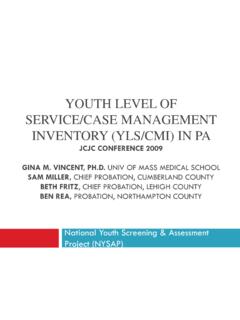Transcription of Review of the Youth Justice System - GOV.UK
1 Review of the Youth Justice System in England and Wales By Charlie Taylor December 2016. Review of the Youth Justice System in England and Wales Presented to Parliament by the Lord Chancellor and Secretary of State for Justice by Command of Her Majesty December 2016. Cm 9298. Crown copyright 2016. This publication is licensed under the terms of the Open Government Licence except where otherwise stated. To view this licence, visit licence/version/3 or write to the Information Policy Team, The National Archives, Kew, London TW9 4DU, or email: Where we have identified any third party copyright information you will need to obtain permission from the copyright holders concerned. This publication is available at Any enquiries regarding this publication should be sent to us at Print ISBN 9781474134873.
2 Web ISBN 9781474134880. ID 22061655 12/16. Printed on paper containing 75% recycled fibre content minimum Printed in the UK by the Williams Lea Group on behalf of the Controller of Her Majesty's Stationery Office Review of the Youth Justice System in England and Wales Contents Chapter 1 Introduction 2. Chapter 2 A more devolved Youth Justice System 6. Chapter 3 Coming into contact with the Youth Justice System 17. Chapter 4 Children in court 27. Chapter 5 Secure schools 36. Chapter 6 The role of central government 45. Chapter 7 A new Youth Justice System 48. Annex A List of main recommendations 50. Acknowledgements 56. 1. Review of the Youth Justice System in England and Wales Chapter 1 Introduction Context 1. In 2007, 225,000 children in England and Wales received a caution or conviction for a notifiable offence1.
3 Of these children, 106,000 were first-time entrants to the System having never before received a caution or conviction. 126,000 were prosecuted at court, and 5,800 were sentenced to custody. The average monthly under-18 custodial population for 2007 was 2,9092. 2. Since that high watermark the number of children dealt with by the Youth Justice System has reduced spectacularly, with consistent year-on-year falls. The number of children cautioned or convicted in 2015 was 47,000 down 79% since 2007. Over the same period the number of children entering the Youth Justice System for the first time has fallen by 82%, the number prosecuted at court has reduced by 69%, and there are now around only 900 under-18s in custody2. 3. In the last decade the demand for Youth Justice services has changed.
4 The police and Youth offending services have, rightly, increasingly sought to deal informally with minor offending by children. The diversion from the Youth Justice System of children who were never likely to continue offending has meant that those who remain are the most difficult to rehabilitate. 4. Among the children now in the Youth Justice System are high numbers of black, Muslim and white working class boys; many are in care, and mental and other health problems, and learning difficulties, are common. These groups are particularly over-represented in custody, where over 40% are from black, Asian and minority ethnic (BAME) backgrounds2, a large proportion have previously been in care (38% in Young Offender Institutions, 52% in Secure Training Centres)3, and more than a third have a diagnosed mental health disorder4.
5 Many of the children in the System come from some of the most dysfunctional and chaotic families where drug and alcohol misuse, physical and emotional abuse and offending is common. Often they are victims of crimes themselves. Though children's backgrounds should not be used as an excuse for their behaviour, it is clear that the failure of education, health, social care and other agencies to tackle these problems have contributed to their presence in the Youth Justice System . 1 Ministry of Justice (2016) Criminal Justice System statistics quarterly: December 2015. 2 Ministry of Justice and Youth Justice Board (2016) Youth custody report: September 2016. 3 HM Inspectorate of Prisons (2015) Children in Custody 2014-2015: Appendices. 4 Harrington, R., Bailey, S., Chitsabesan, P.
6 , Kroll, L., Macdonald, W., Sneider, S., & Barrett, B. (2005). Mental health needs and effectiveness of provision for young offenders in custody and in the community. Youth Justice Board for England and Wales. 2. Review of the Youth Justice System in England and Wales 5. Yet these are children for whom a traditional criminal Justice response has been shown to be, on its own, inadequate. Sixty-four per cent of children given a Youth Rehabilitation Order by the court, and 69% of those sentenced to custody, go on to reoffend within a year5. If the Youth Justice System is truly to protect the public, it must succeed in changing the lives of these most troubled children. To do this, a System set up almost two decades ago to tackle a different problem must evolve to respond imaginatively and proportionately to the challenges of today.
7 Principles and aims for the Review 6. It is right that children who break the law are dealt with differently to adults. Children act impulsively and often do not appreciate the consequences of their actions; they are not emotionally developed and may struggle to communicate effectively. This is particularly true of so many of the children who offend, who often have learning or speech and communication problems. But children also have great strengths on which to build and are capable of rapid and extraordinary change. There needs to be a shift in the way society, including central and local government, thinks about Youth Justice so that we see the child first and the offender second. offending should not mean forfeiting the right to childhood. If children who offend are to become successful and law-abiding adults, the focus must be on improving their welfare, health and education their life prospects rather than simply imposing punishment.
8 7. Almost all of the causes of childhood offending lie beyond the reach of the Youth Justice System . It is vital that health, education, social care and other services form part of an integrated, multi-agency response to a child's offending , but it is more desirable that these same services intervene with at-risk children and families before their problems manifest themselves in offending . I believe this is best achieved by devolving greater freedoms and responsibility for the Youth Justice System to local authorities who otherwise hold the statutory accountability for educating and protecting children. By aligning these responsibilities stronger incentives can be created for a child's offending and related difficulties to be tackled promptly, proportionately and with the least cost to the taxpayer.
9 To help professionals to exercise these functions effectively, I propose stripping back the prescription and bureaucracy associated with a centrally controlled System and creating a clearer inspection and accountability framework, so that practitioners are judged on the outcomes that they achieve rather than the processes they follow. 8. It is my view that education needs to be central to our response to Youth offending . All children in England are required to be in education or training until their 18th birthday, but too often children in the Youth Justice System have been out of school for long periods of time through truancy or following exclusion. As a result, half of 15-17 year olds in YOIs have the literacy or numeracy levels expected of a 7-11. year old6. Schools and colleges are crucial in preventing offending .
10 If children are busy during the day, undertaking activity that is meaningful and that will help them to succeed in life, whether it be studying for exams, learning a trade or playing sport or 5 Ministry of Justice (2016) Proven reoffending statistics quarterly: July 2013 to June 2014, Table C1b. 2014. 6 Ministry of Justice (2013) Analysis of Education Funding Agency administrative data, published in Transforming Youth Custody. putting-education-at-the-heart-of-detent ion 3. Review of the Youth Justice System in England and Wales music, they are much less likely to offend. Education and training are also the building blocks on which a life free from crime can be constructed. By forging closer links between schools, colleges and Youth offending services, and by transforming Youth custody into Secure Schools, drawing in expertise from the best alternative provision schools, children can be equipped with the skills, qualifications and confidence to move beyond offending and fulfil their potential.

















